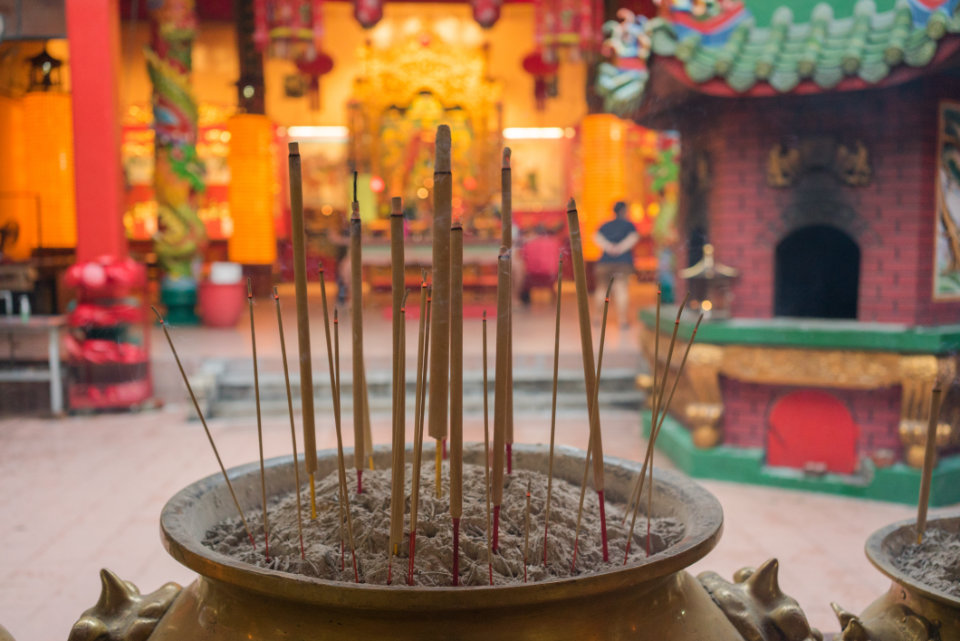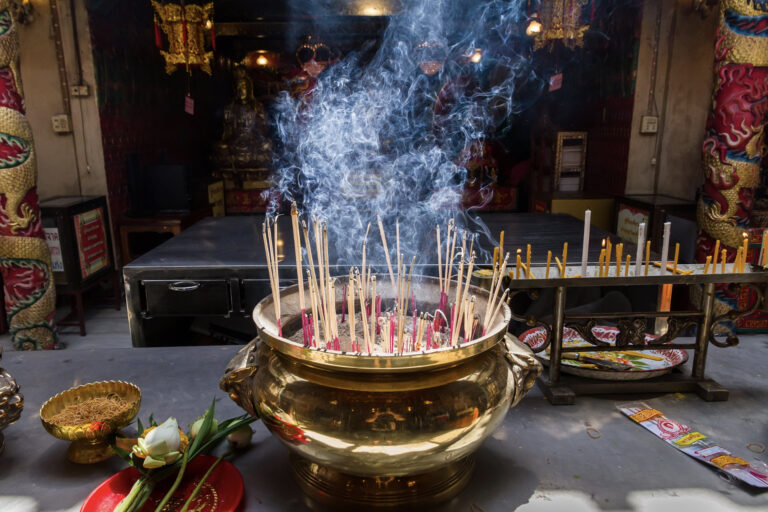Since ancient times, the Chinese people have embraced the practice of burning incense to worship deities and honor the Buddha.
Incense burners are an essential tool for this ritual, symbolizing not only a cultural accumulation and the inheritance of faith but also auspicious completeness, the accumulation of blessings and wisdom, and the expression of aspirations for a meaningful life.
Incense burners play a significant role in these traditions. Whenever we burn incense to worship deities and the Buddha with a sincere and respectful heart, merit is generated.
Each stick of incense inserted adds to this merit, and over time, the incense burner, filled with the essence of devotion, gains power. This helps guard the home, ward off evil, and maintain domestic peace.
From the perspective of Feng Shui, incense burners, with their treasure basin-like shape, have the ability to gather wind and energy, unify family members, and retain wealth, thus contributing to a family’s prosperity.
The thriving fire within incense burners also symbolizes the flourishing of the family and future generations, making them an integral part of spiritual and familial well-being.
Table of Contents
Feng Shui Considerations of Incense Burners
Incense burner Feng Shui and the etiquette of incense burning are crucial aspects that those who worship deities and Buddha must take seriously. They should not be dismissed or taken lightly.
What, then, are the specific considerations and details to be mindful of?
Selection of Incense Burners
- Size of Incense Burner:
The size of the incense burner should be moderate; too large or too small may affect the accumulation of wealth. The size must match the deity’s image; a larger deity requires a larger burner, and a smaller one requires a smaller burner. Generally, the incense burner should not be taller than the deity’s knee (considered too large) or shorter than the feet (considered too small). - Shape of Incense Burner:
There are square and round incense burners. The square ones are typically used to worship ancestors and landlords; celestial deities and other gods generally require round burners. With changing times, some families also use round burners to worship ancestors, which is acceptable. “Round” represents completeness and harmony, signifying family unity and smooth relations without conflicts. - Incense Burner Decoration:
The patterns on the incense burner, known as “decorations,” vary greatly in traditional designs. They are rich in symbolism but must be chosen with care. For instance, burners used to worship ancestors are typically plain and without decoration, while those for celestial deities and greater gods may have decorations.
Placement of Incense Burners
Incense burners are generally placed in front of statues or name tablets and should not be tilted. If there are multiple deities in the home, you may place a single burner in the central altar. If multiple burners have been used, and everything has been going well, there’s no need to change.
However, if there’s discord or financial difficulties, it’s advisable to consult a Feng Shui master and choose an auspicious time to switch to a single burner.
Filling the Incense Burner
When filling the incense burner with ash, it’s essential to find the right balance. Filling it neither too full nor too sparse is key; having too much ash can symbolize a leakage of wealth, while too little may cause the incense to become unstable. Ideally, the burner should be filled to about 90% of its capacity.

Worship Etiquette with Incense Burners
- Communication with the Divine: Burning incense through incense burners is a sincere gesture to communicate and honor gods and Buddha. The fragrance and smoke symbolize our genuine offerings and prayers.
- Daily Devotion: Using incense burners once in the morning and once in the evening demonstrates our heartfelt devotion. The rising smoke from the burners carries our wishes and seeks divine blessings.
- Purification: Incense smoke from the burners purifies both the environment and the soul, eliminating mundane smells, mental obstacles, and airborne bacteria.
- Respectful Behavior: When utilizing incense burners, maintain a respectful and calm heart. Avoid anger or negative speech, as it disrespects the divine and lessens blessings.
- Quality of Incense: Not all incense is suitable for incense burners when worshiping. Choose fragrant and high-quality incense that represents sincere intentions. Good incense in incense burners promotes calmness, eliminates worries, and brings peace and joy.
Emphasizing the role of incense burners in these practices highlights their importance in creating a proper environment for worship and spiritual reflection. The right incense and incense burners not only honor the gods and Buddha but also bring personal peace and wellbeing.
Number of Incense Sticks – Odd Numbers
The number of incense sticks burned must be odd, as odd numbers represent the Yang, the positive side, and symbolize auspiciousness. Even numbers are Yin, so when worshiping gods, Buddhas, and ancestors, we use an odd number, and when honoring close brothers, we use an even number.
We usually hold the incense with our left hand and light it with our right hand, then offer one stick to the gods and ancestors on ordinary days.
On significant festivals (including deities’ birthdays, traditional holidays, and the 1st and 15th of the lunar month), we may burn three sticks. If you burn three sticks on both ordinary days and festivals, it’s fine, and for the earth deity, we usually burn one or five sticks.
Here is what the number of incense sticks represents:
- 1 stick: For peace, typically offered to household gods and ancestors, morning and evening, praying for the family’s well-being.
- 3 sticks: Three sticks are for the Three Treasures of Taoism, or for the Three Pure Ones – the Jade Pure, the Upper Pure, and the Great Pure. Three also represents many meanings, such as worshiping gods, summoning lost souls, performing rituals, and cultivating the heart. This is the way most people burn incense.
- 5 sticks: Used when worshiping the earth deity.
- 9 sticks: Nine sticks symbolize the connection between thirty-three heavens and thirty-three lands, calling upon the Jade Emperor and the Yama Kings.
- 12 sticks: Used during wedding ceremonies and ancestral rituals.
How to Hold the Incense
After lighting three sticks, face the deity, hold the incense with your right hand, and embrace it with your left hand. Raise the incense to the height of your brows, silently pray for what you desire, and bow with your eyes closed.
How to Insert the Incense
After worshiping, insert the incense into the burner. You may insert all at once or separately, but note that the first stick must be in the center to honor Buddha; the second on the left for Dharma; the third on the right for Sangha. The sticks should be straight and evenly spaced, not too far apart.
Appearance and Cleanliness
When burning incense, one must be neat, well-dressed, and not wear sleepwear or sensual clothing, or any clothing with strange odors, or have a bare upper body.
Clean your hands before handling the incense, as hands may carry impurities. These are the basic etiquettes of burning incense and show respect to the gods and Buddhas.
Cleaning the Incense Burner
- Accumulation of Ash: As you burn incense morning and evening in practices such as worshipping to Tiger God, the God of Wealth, Guan Gong, and Guan Yin, the ash accumulates in the burner.
- Proper Handling of Burner: Once the incense burner is full, handle it with care. Ash falling outside the burner during worshipping to the God of Wealth can symbolize leakage of wealth. Always use a spoon to remove the excess ash, avoiding dumping it.
- Filling with Ash or Sand: Whether worshipping to Tiger God or other deities, after cleaning the ash from the incense burner, refill it with fresh ash or fine sand. Level it and press it down to create a firm base for the incense sticks.
- Incense Feet and Sticks: During the cleaning process, particularly when worshipping to Guan Gong or Guan Yin, remove the incense feet but leave 1, 3, or 5 sticks, depending on the specific deity being honored.
- Cleanliness: Regularly keep the altar and the area surrounding the incense burner clean, be it for worshipping to Tiger God, the God of Wealth, Guan Gong, or Guan Yin.
- Disposal of Excess Ash and Incense Feet: After cleaning, especially following rituals such as worshipping to Guan Yin, the excess ash and incense feet can be dissolved and sprinkled under a tree, avoiding stepping on them. City dwellers worshipping to the God of Wealth or other deities can bag the residues and dispose of them in the trash.
- Cleaning Schedule: Whether you are worshipping to Tiger God or any other deities, the incense burner can be cleaned on the 1st, 15th, or any suitable worshipping day.
These guidelines provide specific considerations for those who use incense burners in their daily worship practices, be it for Tiger God, the God of Wealth, Guan Gong, or Guan Yin.
Proper care and handling not only show respect to the deities but also maintain the spiritual integrity of the rituals.
Taboos of Incense Burners
- Re-Sticking Incense Sticks: Once an incense stick has been placed into the burner, it must not be removed and re-stuck. Doing so is considered highly disrespectful and can be seen as a sign of insincerity in your offerings or prayers. It may disrupt the connection with the spiritual world and is believed to bring bad luck.
- Choosing the Correct Incense Color: The color of incense sticks has significant meaning in various cultural contexts. Typically, red incense sticks are used for worshipping deities, symbolizing good fortune and joy, while green sticks are often used for honoring the deceased and used during funeral rituals, symbolizing a peaceful passage. Switching to the correct color for the appropriate occasion is vital, as using the wrong color can be seen as a sign of ignorance or disrespect towards the spiritual beings you are honoring.
- “3 Long and 2 Short” Burning Pattern (三长两短): In some traditions, the burning pattern of the incense sticks, specifically “3 long and 2 short,” has a symbolic meaning. This phrase is often used in Chinese culture to describe a family of five and can be seen as a negative omen if this pattern appears during the burning of incense. If such a pattern is observed, it is typically remedied by adding or removing incense sticks to change the pattern, thereby neutralizing the ominous sign.
Understanding and adhering to these taboos is essential for those who are engaged in the practice of incense burning, whether for religious, spiritual, or cultural reasons.
Disregarding these principles can lead to unintended disrespect or even the attracting of negative energy.
Therefore, being mindful of these practices helps in maintaining a harmonious connection with the spiritual realm and shows reverence towards the traditions and beliefs associated with incense burning.
Misconception in Worshiping: Is Sincerity Enough?
Some people believe that worshiping gods doesn’t require adherence to many rules or etiquettes, arguing that sincerity alone should suffice.
However, one must consider that if basic etiquette isn’t taken seriously, can one genuinely claim to be ‘sincere’? Therefore, it’s essential to learn and practice proper worship to truly honor the gods and Buddhas.
What types of incense are best for Feng Shui practices?
Traditionally, natural incense made from herbs, resins, and essential oils is considered best for Feng Shui, as they contain properties that can enhance the flow of positive energy.
Where should an incense burner be placed in a room according to Feng Shui?
The placement of the incense burner should be in a designated spiritual area or an area of the home that needs energy cleansing, such as near the front door to cleanse incoming energy.
How often should incense be burned for good Feng Shui?
Incense can be burned daily or as needed to clear negative energies. There’s no strict rule, but consistency in practice enhances the positive flow of energy.
Can burning incense negatively affect Feng Shui?
Burning low-quality, synthetic incense or placing the incense burner in inappropriate areas of the home can create negative energy and disrupt the balance of Feng Shui.
Is it necessary to follow a particular direction while burning incense in Feng Shui?
While not a strict requirement, aligning the incense burning with the Bagua map of your space, targeting specific areas for improvement, can enhance the effectiveness of the ritual.
What should I avoid when burning incense in Feng Shui?
Avoid using incense made with artificial fragrances, placing the incense burner in cluttered or inappropriate areas, and neglecting to clean the ash or replace the incense as these can create negative energies.
Can I use incense burning for specific Feng Shui goals, such as attracting wealth or love?
Yes, different types of incense can be used for specific intentions in Feng Shui. Research or consult with a Feng Shui master to choose the right incense for your particular goal.



